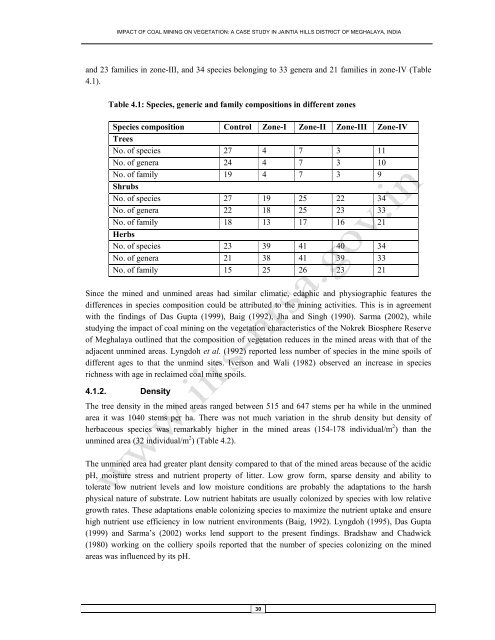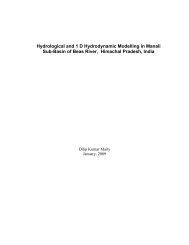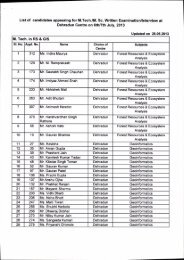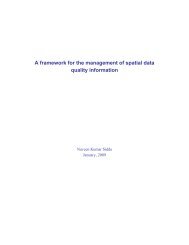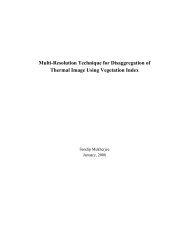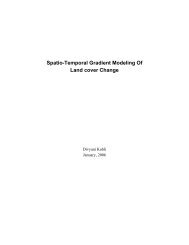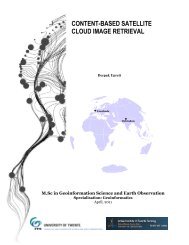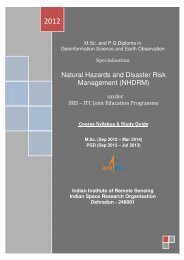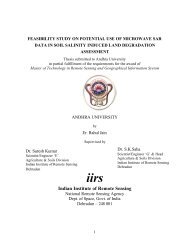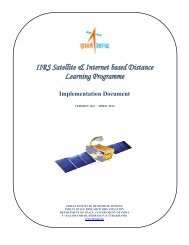IMPACT OF COAL MINING ON VEGETATION: A CASE STUDY IN JAINTIA HILLS DISTRICT OF MEGHALAYA, INDIA4. Results and Discussi<strong>on</strong>Ecosystem disturbance may be def<strong>in</strong>ed as an event or series <str<strong>on</strong>g>of</str<strong>on</strong>g> events that alters the relati<strong>on</strong>ship <str<strong>on</strong>g>of</str<strong>on</strong>g>organisms and their habitat <strong>in</strong> time and space. Ecosystem disturbance by m<strong>in</strong><strong>in</strong>g is an evitable fall out<str<strong>on</strong>g>of</str<strong>on</strong>g> <strong>in</strong>dustrializati<strong>on</strong> and modern civilizati<strong>on</strong>. <str<strong>on</strong>g>M<strong>in</strong><strong>in</strong>g</str<strong>on</strong>g> <str<strong>on</strong>g>of</str<strong>on</strong>g> coal both surface and subsurface causesenormous damage to the flora, fauna, hydrological relati<strong>on</strong>s and soil biological systems. Destructi<strong>on</strong> <str<strong>on</strong>g>of</str<strong>on</strong>g>the vegetal cover dur<strong>in</strong>g m<strong>in</strong><strong>in</strong>g operati<strong>on</strong> is <strong>in</strong>variably accompanied by an extensive damage and lossto the system. The disturbed and haphazardly mixed <strong>in</strong>fertile, c<strong>on</strong>solidated and unc<strong>on</strong>solidatedmaterials overly<strong>in</strong>g the coal seams are known as overburdens. These overburdens when dumped <strong>in</strong>unm<strong>in</strong>ed areas <strong>in</strong> the vic<strong>in</strong>ity <str<strong>on</strong>g>of</str<strong>on</strong>g> the coal m<strong>in</strong>es create m<strong>in</strong>e spoils. Nutrient deficient sandy spoils aregenerally hostile to plant growth. The dump<strong>in</strong>g <str<strong>on</strong>g>of</str<strong>on</strong>g> spoils and coal destroys even the surround<strong>in</strong>gvegetati<strong>on</strong> and leads to severe soil and water polluti<strong>on</strong>. The Ja<strong>in</strong>tia <strong>Hills</strong> district <str<strong>on</strong>g>of</str<strong>on</strong>g> Meghalaya hasbeen extensively extracted <strong>in</strong> terms <str<strong>on</strong>g>of</str<strong>on</strong>g> coal. As a result <str<strong>on</strong>g>of</str<strong>on</strong>g> this, many parts <str<strong>on</strong>g>of</str<strong>on</strong>g> the district has beenc<strong>on</strong>verted from lush green landscape <strong>in</strong>to m<strong>in</strong>e spoils. Large scale denudati<strong>on</strong> <str<strong>on</strong>g>of</str<strong>on</strong>g> forest cover, scarcity<str<strong>on</strong>g>of</str<strong>on</strong>g> water, polluti<strong>on</strong> <str<strong>on</strong>g>of</str<strong>on</strong>g> air, water and soil, and degradati<strong>on</strong> <str<strong>on</strong>g>of</str<strong>on</strong>g> agricultural lands are some <str<strong>on</strong>g>of</str<strong>on</strong>g> thec<strong>on</strong>spicuous envir<strong>on</strong>mental implicati<strong>on</strong>s <str<strong>on</strong>g>of</str<strong>on</strong>g> coal m<strong>in</strong><strong>in</strong>g <strong>in</strong> Ja<strong>in</strong>tia <strong>Hills</strong>.A detailed understand<strong>in</strong>g <str<strong>on</strong>g>of</str<strong>on</strong>g> the impact <str<strong>on</strong>g>of</str<strong>on</strong>g> coal m<strong>in</strong><strong>in</strong>g <strong>on</strong> vegetati<strong>on</strong> and plant diversity <strong>on</strong> time andspace is pre-requisite for the district. Keep<strong>in</strong>g this objective <strong>in</strong> view, the first part <str<strong>on</strong>g>of</str<strong>on</strong>g> this chapter willdiscuss the plant community characteristics <str<strong>on</strong>g>of</str<strong>on</strong>g> the area and the impact <str<strong>on</strong>g>of</str<strong>on</strong>g> coal m<strong>in</strong><strong>in</strong>g <strong>on</strong> them hasbeen assessed by compar<strong>in</strong>g certa<strong>in</strong> community attributes <str<strong>on</strong>g>of</str<strong>on</strong>g> the m<strong>in</strong>ed areas with that <str<strong>on</strong>g>of</str<strong>on</strong>g> the adjacentum<strong>in</strong>ed area. The sec<strong>on</strong>d part will deal with temporal impact <str<strong>on</strong>g>of</str<strong>on</strong>g> m<strong>in</strong><strong>in</strong>g activities <strong>on</strong> vegetati<strong>on</strong>. Inorder to achieve this objective the land cover types <str<strong>on</strong>g>of</str<strong>on</strong>g> dense forest, open forest and m<strong>in</strong><strong>in</strong>g area weredel<strong>in</strong>eated. The area under crop, settlement and grassland/ n<strong>on</strong>-forest were also taken <strong>in</strong>toc<strong>on</strong>siderati<strong>on</strong> to know the trend due to the impact <str<strong>on</strong>g>of</str<strong>on</strong>g> m<strong>in</strong><strong>in</strong>g activities <strong>in</strong> different time periods.4.1. Community Characteristics4.1.1. Floristic Compositi<strong>on</strong>There were variati<strong>on</strong>s <strong>in</strong> the compositi<strong>on</strong> <str<strong>on</strong>g>of</str<strong>on</strong>g> plant <strong>in</strong> the m<strong>in</strong>ed and unm<strong>in</strong>ed areas. The tree speciesshowed a drastic reducti<strong>on</strong> <strong>in</strong> their number <strong>in</strong> all z<strong>on</strong>es <str<strong>on</strong>g>of</str<strong>on</strong>g> the m<strong>in</strong><strong>in</strong>g sites (3-11) with that <str<strong>on</strong>g>of</str<strong>on</strong>g> theunm<strong>in</strong>ed sites (27). In the unm<strong>in</strong>ed site 27 tree species bel<strong>on</strong>g<strong>in</strong>g to 22 genera and 19 families wereregistered. Four (4) tree species bel<strong>on</strong>g<strong>in</strong>g to 4 genera and 4 families, 7 tree species bel<strong>on</strong>g<strong>in</strong>g to 7genera and 7 families, 3 tree species bel<strong>on</strong>g<strong>in</strong>g to 3 genera and 3 families, and 11tree speciesbel<strong>on</strong>g<strong>in</strong>g to 10 genera and 9 families were recorded <strong>in</strong> the m<strong>in</strong>ed areas <str<strong>on</strong>g>of</str<strong>on</strong>g> z<strong>on</strong>e-I, z<strong>on</strong>e-II, z<strong>on</strong>e-IIIand z<strong>on</strong>e-IV, respectively. It was apparent from the study that the number <str<strong>on</strong>g>of</str<strong>on</strong>g> tree species was more <strong>in</strong>the peripheral z<strong>on</strong>e than the <strong>in</strong>ner z<strong>on</strong>es. There was not much variati<strong>on</strong> <strong>in</strong> the number <strong>in</strong> first threez<strong>on</strong>es <str<strong>on</strong>g>of</str<strong>on</strong>g> the area. The shrub species did not show much variati<strong>on</strong> <strong>in</strong> the unm<strong>in</strong>ed and all the z<strong>on</strong>es <str<strong>on</strong>g>of</str<strong>on</strong>g>the m<strong>in</strong>ed areas. In the unm<strong>in</strong>ed area, total 27 shrub species bel<strong>on</strong>g<strong>in</strong>g to 22 genera and 18 familieswere found. Shrubs were represented by 19, 25, 22 and 34 species from 18, 25, 23 and 33 genera, and13, 17, 16 and 21 families were recorded from z<strong>on</strong>e-I, z<strong>on</strong>e-II, z<strong>on</strong>e-III and z<strong>on</strong>e-IV, respectively.There was remarkable <strong>in</strong>crease <strong>in</strong> the number <str<strong>on</strong>g>of</str<strong>on</strong>g> herbaceous species <strong>in</strong> the m<strong>in</strong>ed areas. In theunm<strong>in</strong>ed area total number <str<strong>on</strong>g>of</str<strong>on</strong>g> ground species recorded were 23 bel<strong>on</strong>g<strong>in</strong>g to 21 genera and 15families. In the m<strong>in</strong>ed areas herbaceous layer was composed <str<strong>on</strong>g>of</str<strong>on</strong>g> 39 species, 38 genera, 25 families <strong>in</strong>the z<strong>on</strong>e-I, 41 species bel<strong>on</strong>g<strong>in</strong>g to 41 genera and 26 families <strong>in</strong> the z<strong>on</strong>e-II, 40 species from 39 genera29
IMPACT OF COAL MINING ON VEGETATION: A CASE STUDY IN JAINTIA HILLS DISTRICT OF MEGHALAYA, INDIAand 23 families <strong>in</strong> z<strong>on</strong>e-III, and 34 species bel<strong>on</strong>g<strong>in</strong>g to 33 genera and 21 families <strong>in</strong> z<strong>on</strong>e-IV (Table4.1).Table 4.1: Species, generic and family compositi<strong>on</strong>s <strong>in</strong> different z<strong>on</strong>esSpecies compositi<strong>on</strong> C<strong>on</strong>trol Z<strong>on</strong>e-I Z<strong>on</strong>e-II Z<strong>on</strong>e-III Z<strong>on</strong>e-IVTreesNo. <str<strong>on</strong>g>of</str<strong>on</strong>g> species 27 4 7 3 11No. <str<strong>on</strong>g>of</str<strong>on</strong>g> genera 24 4 7 3 10No. <str<strong>on</strong>g>of</str<strong>on</strong>g> family 19 4 7 3 9ShrubsNo. <str<strong>on</strong>g>of</str<strong>on</strong>g> species 27 19 25 22 34No. <str<strong>on</strong>g>of</str<strong>on</strong>g> genera 22 18 25 23 33No. <str<strong>on</strong>g>of</str<strong>on</strong>g> family 18 13 17 16 21HerbsNo. <str<strong>on</strong>g>of</str<strong>on</strong>g> species 23 39 41 40 34No. <str<strong>on</strong>g>of</str<strong>on</strong>g> genera 21 38 41 39 33No. <str<strong>on</strong>g>of</str<strong>on</strong>g> family 15 25 26 23 21S<strong>in</strong>ce the m<strong>in</strong>ed and unm<strong>in</strong>ed areas had similar climatic, edaphic and physiographic features thedifferences <strong>in</strong> species compositi<strong>on</strong> could be attributed to the m<strong>in</strong><strong>in</strong>g activities. This is <strong>in</strong> agreementwith the f<strong>in</strong>d<strong>in</strong>gs <str<strong>on</strong>g>of</str<strong>on</strong>g> Das Gupta (1999), Baig (1992), Jha and S<strong>in</strong>gh (1990). Sarma (2002), whilestudy<strong>in</strong>g the impact <str<strong>on</strong>g>of</str<strong>on</strong>g> coal m<strong>in</strong><strong>in</strong>g <strong>on</strong> the vegetati<strong>on</strong> characteristics <str<strong>on</strong>g>of</str<strong>on</strong>g> the Nokrek Biosphere Reserve<str<strong>on</strong>g>of</str<strong>on</strong>g> Meghalaya outl<strong>in</strong>ed that the compositi<strong>on</strong> <str<strong>on</strong>g>of</str<strong>on</strong>g> vegetati<strong>on</strong> reduces <strong>in</strong> the m<strong>in</strong>ed areas with that <str<strong>on</strong>g>of</str<strong>on</strong>g> theadjacent unm<strong>in</strong>ed areas. Lyngdoh et al. (1992) reported less number <str<strong>on</strong>g>of</str<strong>on</strong>g> species <strong>in</strong> the m<strong>in</strong>e spoils <str<strong>on</strong>g>of</str<strong>on</strong>g>different ages to that the unm<strong>in</strong>d sites. Ivers<strong>on</strong> and Wali (1982) observed an <strong>in</strong>crease <strong>in</strong> speciesrichness with age <strong>in</strong> reclaimed coal m<strong>in</strong>e spoils.4.1.2. DensityThe tree density <strong>in</strong> the m<strong>in</strong>ed areas ranged between 515 and 647 stems per ha while <strong>in</strong> the unm<strong>in</strong>edarea it was 1040 stems per ha. There was not much variati<strong>on</strong> <strong>in</strong> the shrub density but density <str<strong>on</strong>g>of</str<strong>on</strong>g>herbaceous species was remarkably higher <strong>in</strong> the m<strong>in</strong>ed areas (154-178 <strong>in</strong>dividual/m 2 ) than theunm<strong>in</strong>ed area (32 <strong>in</strong>dividual/m 2 ) (Table 4.2).The unm<strong>in</strong>ed area had greater plant density compared to that <str<strong>on</strong>g>of</str<strong>on</strong>g> the m<strong>in</strong>ed areas because <str<strong>on</strong>g>of</str<strong>on</strong>g> the acidicpH, moisture stress and nutrient property <str<strong>on</strong>g>of</str<strong>on</strong>g> litter. Low grow form, sparse density and ability totolerate low nutrient levels and low moisture c<strong>on</strong>diti<strong>on</strong>s are probably the adaptati<strong>on</strong>s to the harshphysical nature <str<strong>on</strong>g>of</str<strong>on</strong>g> substrate. Low nutrient habitats are usually col<strong>on</strong>ized by species with low relativegrowth rates. These adaptati<strong>on</strong>s enable col<strong>on</strong>iz<strong>in</strong>g species to maximize the nutrient uptake and ensurehigh nutrient use efficiency <strong>in</strong> low nutrient envir<strong>on</strong>ments (Baig, 1992). Lyngdoh (1995), Das Gupta(1999) and Sarma’s (2002) works lend support to the present f<strong>in</strong>d<strong>in</strong>gs. Bradshaw and Chadwick(1980) work<strong>in</strong>g <strong>on</strong> the colliery spoils reported that the number <str<strong>on</strong>g>of</str<strong>on</strong>g> species col<strong>on</strong>iz<strong>in</strong>g <strong>on</strong> the m<strong>in</strong>edareas was <strong>in</strong>fluenced by its pH.30


